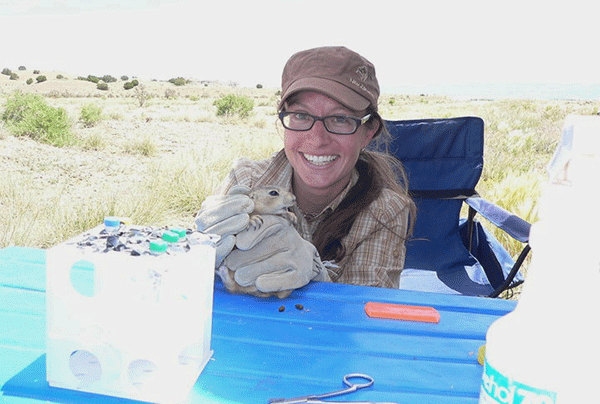International research isn’t foreign to Dr. Loren Cassin-Sackett.
The assistant professor of biology at the University of Louisiana at Lafayette examines genetic material to explore the influence of wildlife diseases on animal evolution and ecology.
As a graduate student, she did fieldwork in Antarctica, Costa Rica and the Galapagos Islands. She also conducted postdoctoral coursework in Germany.
Today, she’s a research affiliate at the Smithsonian Institution; though based in Washington, D.C., its collections attract scientists from around the globe. “It’s a very international place,” she said.
Cassin-Sackett received yet another stamp on her research passport this spring semester. Her destination: Colombia.
There, as a Fulbright scholar, she’s collaborating with scientists at the Universidad de Los Andes in Bogotá to examine if pathogens, bacteria and microbes found in an animal’s gut – in this case, the gut of the capybara, the world’s largest rodent – heighten its risk of acquiring infectious diseases.
The study also holds implications for humans, Cassin-Sackett said. “The pathogens we are looking for in capybaras are also pathogens that infect humans. In some regions, capybaras can come into close contact with humans.”
She continued: “Humans are at risk of contracting pathogens from animals, particularly rodents and primates because those are our closest evolutionary relatives. Understanding what increases the risk of that pathogen in the capybara can help us understand the risk of it spilling over into humans.”
The Fulbright Program was founded in 1946. It is one of the world’s most prestigious cultural exchange and scholarship programs.
Cassin-Sackett’s stay in Colombia began in January and concludes in June. She discussed her expectations for her time there before her departure.
Question: What’s the appeal of Colombia?
Answer: Colombia has the second-highest number of species of any country, which is really astounding. It’s right next to Brazil, which has the most species. It has this amazing elevation gradient, so you have all kinds of species at low and high elevations. The diversity of habitats there is incredible. That’s part of why it’s appealing to me. I’m a biologist, so what better place to go than one that has tons of biodiversity.
Q: You’ve used genomics – DNA mapping – here at UL Lafayette in your research. Universidad de Los Andes is a pioneer in using genomics to understand how pathogens interact with animals, marine mammals, crops and humans. What’s the benefit of genomic methods to the work you’ve done here and to what you’ll be doing there?
A: Genomic methods enable scientists to sequence huge amounts of DNA, sometimes whole genomes. It’s a fast and efficient way of getting at a ton of data. Being able to look at more of the genome gives us a more accurate understanding of evolution.
But that’s only part of it. You can also identify what you are looking at using genomes. One of the things I am going to be doing is looking for pathogens. You often can identify those pathogens better with a DNA sequence than you can with your eyeball. Partly that’s because they are microscopic, or they have a low prevalence in the animal, so it would take you forever to look through slides under a microscope. So, sequencing is an efficient way to do this.
Q: You’re going to be looking for microbes found in the capybara’s gut. How do you get your data?
A: Through poop. It’s very glamorous.
Q: Why study capybaras?
Scientists are drawn to exceptional species because we can learn a lot from them. Capybaras are unusual; most rodents are small. Capybaras can weigh up to 150 pounds.
Capybaras are also interesting because they’re very social and form large aggregations which is unusual for a rodent. I study another social rodent, prairie dogs of the American West.
Q: What is the benefit of international collaborations such as those fostered by Fulbright?
A: I was thinking how the scientific enterprise has changed over the last century. It used to be individuals working on their own and coming up with ideas. Now, we have innumerable methods to test hypotheses, and so as a result of these new methods and technologies, science has become incredibly collaborative. These collaborations propel science forward.
It’s really about perspective. We all have our own way of looking at the world. You get new ideas when you get new perspectives. You learn to think about things in a different way, and I think that’s where scientific discoveries happen, when you are looking at things from a new perspective you didn’t have before.
